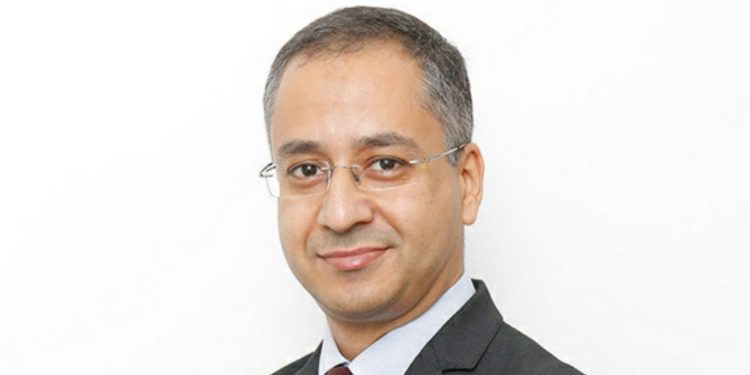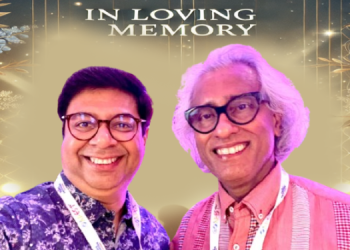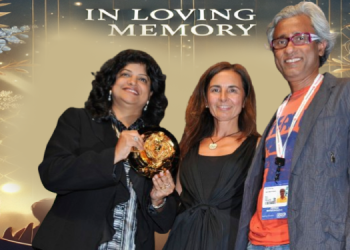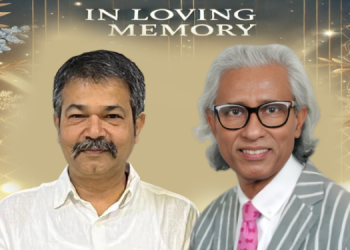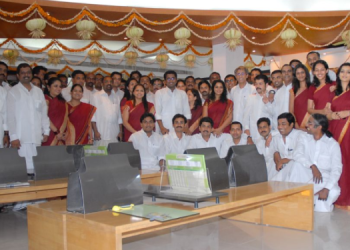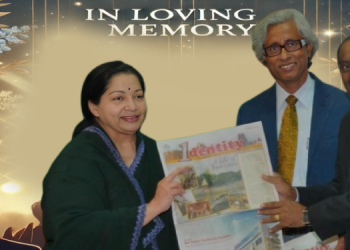BY: Yohan P Chawla
A special screening was organized of the documentary on the work that goes behind organizing the general elections of the world’s largest democracy titled India Inked by HistoryTV18. This one off documentary shows how the election commission of India organizes a general election across the entire country with some heartwarming stories.
On the sidelines of this screening Medianews4u caught up with Avinash Kaul, CEO, Network18 & MD A+E Networks TV 18 to talk about the documentary, factual entertainment business of TV18, growth prospects, their news business and a lot more.
Edited excerpts.
What are your thoughts on India Inked and its format of storytelling? Are we going to see any more such interesting single one off documentaries on History TV18?
Yes we’ve been at the forefront of doing original content in India with regards to factual entertainment. For our show OMG Yeh Mera India we’re commissioning more seasons, we are doing the one offs because some stories are best made for one offs and some are evergreen series that we’re trying to create. We do see a huge future for that and only the economics of it is basically what’s coming in the way. Internally, when we talk about the news organization most of the colleagues ask me why can’t we do more such things across the entire network? It’s just, pure economics. Lots more stories and a lot more great compelling content is there but the business models of yet not fully supportive of these kinds of investments. The top 10 channels in USA being from the factual entertainment that reflects about the amount of content being created and the quality of the content that has been created there.
Here, since it’s literally based on wherever the people meters are and that makes it a little more massy so we don’t find that kind of a content traction, from a rating standpoint, in comparison to what you would find on a mass entertainment channel.
Does Network18’s digital properties help in the economics of creating these one off shows?
It does but to an extent. For example if you see a Bollywood movie, there was a time when hundred percent of its recovery used to happen from theatrical and hit and flop was based on that. Now you have all kinds of revenue streams, you have digital, OTT, DTH, terrestrial satellite rights, karaoke rights, music rights, book rights, twenty thousand kinds of rights are available and each one funds this particular project. And most of the projects become viable probably even before they reach the theaters. Now, it’s taken that amount of time for it to reach that particular cycle, the news industry or the television industry the first steps have just been taken with the NTO right, with the pricing now being declared for everything. It’s still early days we don’t know how long it’s going to last for the true value to be incurred. At the same time, Indians have now got used to the concept of being able to pay for content separately which is seen in the OTT space. Earlier the 300 rupees one would pay for cable to get 800 channels had a value attached to it. Now, when you’re paying, 300 bucks a month or say 700 bucks in certain case like Netflix, then you realize the quality of content can actually go significantly higher the moment you are actually willing to pay for it.
I’m saying each one makes it makes a sliding scale. But as long as it is going upward and beyond right now think of it as one channel. Its one channel 200 rupees. There is if you see any of the TV channels, including GEC is nobody’s priced at 200 rupees so the model is right now built on masses with low price points, because India is a price sensitive market, even the regulator is very keen that the prices become low. When the prices become low, then obviously you’re looking at volumes. And obviously, when you’re looking at volumes, then the quality benchmarks do not necessarily remain the same. So for these things to happen, the model needs to evolve a bit and quite a lot of these funding will come into play, the digital monetization hasn’t really taken off till now. When it comes to syndication markets that come into the fold many other ways of doing business come to fold, then it is much easier to get into projects like these.
How did you plan logistics for India Inked? How long did it take to create this documentary?
It’s a three to four months exercise and there is a lot of pre-work involved which is very extensive and everything is based on real activities. The end couldn’t have been done till the election wasn’t done and dusted as an example because nobody had an idea of who’s going to win and what’s going to happen. So it’s an ongoing exercise and anything and everything can go off. Maybe there is some attempt which happens at some polling booth something gets derailed or some other thing happens. It’s a lot of in probabilities which you are faced with but then that’s where the fun comes in and that’s where you begin to mount some things and that’s something that we have seen viewers resonate a lot with it. When we did the surgical strikes film. I mean, the amount of response on the digital platforms was stupendous. And we’re hoping that this one again instills that feeling of pride in Indians to what kind of a magnitude of operation does it take to get an election like this done.
What sort of digital push are you planning to give the documentary? Mainly YouTube, or are we are looking at other social media platforms too.
It will be across all the Network18 social media channels and properties. Eventually we will see this film on all the news networks of Network18 and we are in conversations with OTT platforms but not fully closed one.
What is the sort of consumption pattern that you see with India Inked kind of content on HistoryTV18? I mean, in terms of a difference between a rural and urban audience?
Local content travels across because the way we do it is we dub the content, or we produce the content and in local languages and dub it into regional languages as well. So it does find its way into all kinds of places including rural significantly. So it’s not just an urban phenomenon or a mega city phenomena. It’s all across.
How has the NTO impacted the Factual Entertainment business of Network18?
In the factual currently after the NTO, I think there is an advertising slowdown kind of a situation that we are seeing right now but that’s across the entire industry. We’re hoping with the festivals coming we should be seeing some corrective measures happening at an industry level to make sure that even the industry reconciles itself to the new normal and then move on from there. From then onwards, I think it’s only a question of how the economics of subscription versus advertising sales takes off because if the model is more towards a subscription based depending on the success of each one of these parameters, then a different kind of a content play comes into place. It’s honestly very early days yet, I think let’s give NTO time to settle in about 10-12 months from now we’ll be in a better position to figure out directionally which way these things are going.
How are the news vertical of Network18 performing?
Well in News we have had a great Q1, we had a 29% growth in overall revenues with a 48% growth in subscriptions and that was primarily on the back of elections and some of our Hindi and regional language channels saw 100% growth as well so it’s been a pretty good start to the year. The month of June and July have not been really that much great for the entire genre, primarily to do with a lot of sporting activity that happened around that time. And generally the economy is also really not in the best of shapes right now as we see it but we’re already seeing the green shoots emerging in August. I think by the time the festival comes in I think we should be all fine.
How do social media platforms and digital news sources pose a threat to the traditional broadcast news business?
See as content creators it really doesn’t bother us that much from where people are consuming our content. Because as a network we are available in print, digital and on TV. So as long as it comes from the house of News18 it really doesn’t matter, where they go, and how they consume content. It doesn’t even matter which language because we create content in all major languages. It doesn’t matter which device whether it’s the big screen or the small screen that they watch us on. When you see us as broadcast we are primarily an audio visual content company and one pipe of it is what you see on the first screen. Once the consumption happens then the business models follow so it’s not always the case that a business model will instantaneously follow a consumption, when there is a sufficient size and scale of consumption, then the business model revolves around that.
Today you get notifications just like that you would see a time when notifications is the only thing that exists and people watch primarily, you could find that notifications get sponsored by brands being ‘brought to you by x’. So everything needs a particular inflection point and volumes of consumption, which is then followed by the monetization engines, it’s never the other way around. So there is a certain gestation period before what you end up doing and what you end up reaping. The attempts on Facebook and the attempts on Twitter on the attempts on any of these platforms are again curating those audiences, because some of the audiences do not want to go onto the big screen now, especially the younger audience, then they want their news in a very different format small bites, and they may or may not be interested in debates. So it depends on which spectrum they come from, and where they want to choose to see us so we give them those flavors.
What are your growth plans and which specific areas are you focusing on for this particular year?
We are already the number one news network in the country with almost 11 and a half percent channel share and our endeavor is to take it upwards. Hopefully, if we end up the year with 15% to 18%, I think that will be a good number to have.
We have 20 new channels in India and one International channel a whole lot of them are in the number one or the number two positions mostly in Hindi language. Some of our regional language channels are not in the top three as yet so that’s the immediate task for us to get all our channels in some fashion in the top two positions. And that would really take up a lot of our energy and bandwidth to make sure that happens. Post that, obviously the number one position in each of the genres is what will be aspiring for. All of this is easier said than done, because each one of our channels has at least eight to 10 competitors, which makes it literally a minefield of competitors around and in all languages so it does require a herculean effort to be able to come on top on all of the genres that you exist in. So it really is not an easy task.
And your factual entertainment growth plans?
We continue on our work on local productions and increasing the value and a lot will depend upon how the business model evolves eventually right but we will continue to make our investments and stay firm to our commitment to the consumers.

